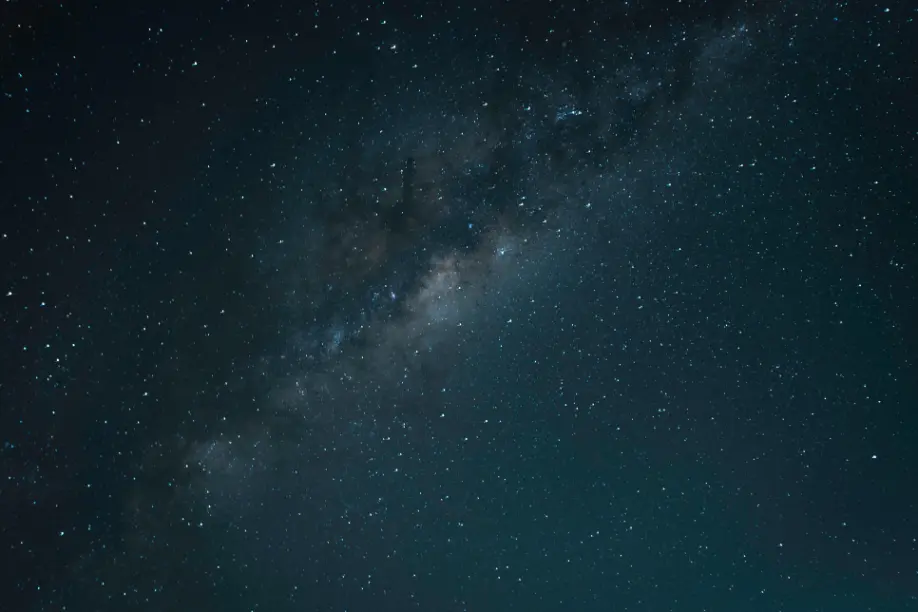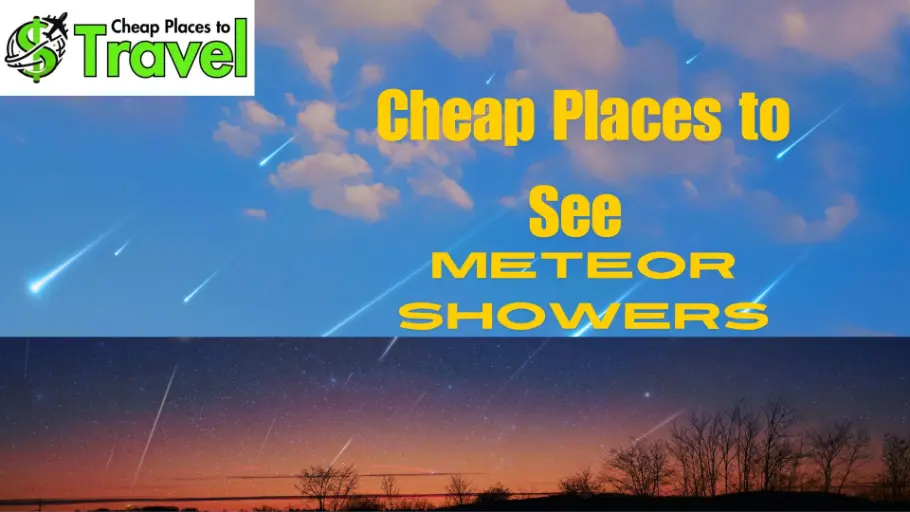The night sky is a canvas of wonder, and meteor showers are one of its most breathtaking spectacles. These celestial events, where the Earth passes through a trail of debris left by comets or asteroids, offer a glimpse into the vastness of space and the beauty of our planet. While many people associate meteor showers with expensive trips to remote observatories or stargazing tours, you don’t need to break the bank to witness this celestial show. Here are cheap places to see meteor showers

This guide will explore some of the best places to see meteor showers in the world to catch a glimpse of these celestial fireworks. We will focus on locations that offer dark skies, minimal light pollution, and convenient access, making them perfect for budget-conscious stargazers. You will choose the best place to see the Perseid meteor shower.
North America- Where the Stars Shine Bright
Best Places to See Meteor Shower in California
Anza-Borrego Desert State Park
Bortle Scale: 3-4 (Dark Rural Sky)

This vast desert park in Southern California offers some of the darkest skies in the state, making it an ideal spot for meteor shower viewing. Its remote location minimizes light pollution, allowing for a truly spectacular show.
The Perseid meteor shower (peak in August), the Orionids (peak in October), and the Geminids (peak in December).
Joshua Tree National Park
Bortle Scale: 4-5 (Rural Sky)

This iconic park, known for its unique Joshua trees and rugged landscapes, is another excellent option for stargazing. Its high elevation and remote location ensure minimal light pollution, creating a canvas for breathtaking meteor showers.
The Perseid meteor shower (peak in August), the Orionids (peak in October), and the Geminids (peak in December).
Death Valley National Park

Bortle Scale: 2-3 (Dark Sky)
This park, known for its extreme temperatures and stunning landscapes, also boasts some of the darkest skies in the United States. Despite its remoteness, Death Valley is easily accessible and offers a unique stargazing experience.
The Perseid meteor shower (peak in August), the Orionids (peak in October), and the Geminids (peak in December).
Where to See Meteor Shower in Florida
Big Cypress National Preserve
Bortle Scale: 4-5 (Rural Sky)

This vast swampy preserve in South Florida offers a unique combination of dark skies and a serene atmosphere. Its remote location and minimal light pollution make it a perfect spot for catching meteor showers.
The Perseid meteor shower (peak in August), the Orionids (peak in October), and the Geminids (peak in December).
Everglades National Park
Bortle Scale: 4-5 (Rural Sky)

This best place to see meteor showers, known for its diverse wildlife and unique ecosystem, also boasts some of the darkest skies in Florida. Its remote location and minimal light pollution make it a perfect spot for stargazing.
The Perseid meteor shower (peak in August), the Orionids (peak in October), and the Geminids (peak in December).
Where to See Meteor Showers in the Bay Area
Mount Tamalpais State Park
Bortle Scale: 6-7 (Suburban Sky)

This park, located just north of San Francisco, offers stunning views of the city skyline and the surrounding Bay Area. While light pollution from the city can be a challenge, the park’s high elevation and open spaces provide some respite from the city lights.
The Perseid meteor shower (peak in August), the Orionids (peak in October), and the Geminids (peak in December).
Henry Cowell Redwoods State Park
Bortle Scale: 6-7 (Suburban Sky)

This park, known for its towering redwood trees, offers a unique and serene setting for stargazing. While light pollution from nearby cities can be a challenge, the park’s dense forest canopy creates a sense of seclusion and allows for some respite from the city lights.
The Perseid meteor shower (peak in August), the Orionids (peak in October), and the Geminids (peak in December).
Where to See Meteor Shower Los Angeles
Griffith Observatory
Bortle Scale: 8-9 (City Sky)

This iconic observatory in Griffith Park offers stunning views of the Los Angeles skyline and the surrounding mountains. While light pollution from the city can be a challenge, the observatory’s telescopes and knowledgeable staff provide a unique stargazing experience.
The Perseid meteor shower (peak in August), the Orionids (peak in October), and the Geminids (peak in December).
Topanga State Park
Bortle Scale: 6-7 (Suburban Sky)

This park, located in the Santa Monica Mountains, offers stunning views of the Pacific Ocean and the surrounding mountains. While light pollution from the city can be a challenge, the park’s remote location and open spaces provide some respite from the city lights.
The Perseid meteor shower (peak in August), the Orionids (peak in October), and the Geminids (peak in December).
Asia– A Stargazer’s Paradise
Where to See Meteor Shower Singapore
MacRitchie Reservoir Park
Bortle Scale: 7-8 (Bright Suburban Sky)

This park, located in the heart of Singapore, offers a surprising amount of dark skies. Its remote location and dense forest canopy provide some respite from the city lights, making it a perfect spot for catching meteor showers.
The Perseid meteor shower (peak in August), the Orionids (peak in October), and the Geminids (peak in December).
Pulau Ubin
Bortle Scale: 4-5 (Rural Sky)

This island, located off the coast of Singapore, is a haven for nature lovers and stargazers. Its remote location and minimal light pollution make it a perfect spot for catching meteor showers.
The Perseid meteor shower (peak in August), the Orionids (peak in October), and the Geminids (peak in December).
Where to See Meteor Shower in Malaysia
Cameron Highlands
Bortle Scale: 3-4 (Dark Rural Sky)

This mountainous region, located in the heart of Malaysia, offers some of the darkest skies in the country. Its high elevation and remote location minimize light pollution, creating a canvas for breathtaking meteor showers.
The Perseid meteor shower (peak in August), the Orionids (peak in October), and the Geminids (peak in December).
Taman Negara National Park
Bortle Scale: 2-3 (Dark Sky)

This park, located in the heart of the Malaysian rainforest is the best place to see the meteor shower. It offers a unique combination of dark skies and a serene atmosphere. Its remote location and minimal light pollution make it a perfect spot for catching meteor showers.
The Perseid meteor shower (peak in August), the Orionids (peak in October), and the Geminids (peak in December).
Tips for Affordable Meteor Shower Viewing:
Plan Ahead
Research the best time and location for the meteor shower you want to see. Consider factors like weather, light pollution, and accessibility.
Go Camping
Camping is a cost-effective way to experience the night sky. Many national parks and forests offer campsites with minimal light pollution.
Travel Off-Season
Traveling during the off-season can significantly reduce travel and accommodation costs.
Pack Your Food and Drinks
Bringing your snacks and drinks can save you money on expensive park concessions.
Dress Warmly
Even on warm nights, temperatures can drop significantly after sunset. Dress in layers to stay comfortable.
Bring a Blanket or Chair
A comfortable blanket or chair will make your stargazing experience more enjoyable.
Be Patient
Meteor showers can be unpredictable, so be patient and give yourself plenty of time to enjoy the show.
Beyond the Stars
While meteor showers are a highlight of any stargazing experience, there are many other celestial wonders to explore. From constellations to planets to galaxies, the night sky offers a never-ending source of wonder and inspiration. You can choose the best place to see meteor shower nearest to you in your budget.
The Departure
Witnessing a meteor shower is an unforgettable experience, and it doesn’t have to be expensive. By choosing affordable locations and following these tips, you can enjoy the beauty of the night sky without breaking the bank. So, grab your blanket, find a dark sky, and prepare to be amazed by the wonders of the universe.
FAQs
What is a meteor shower?
A meteor shower occurs when the Earth passes through a stream of debris left behind by a comet or asteroid. As these small particles enter the Earth’s atmosphere, they burn up, creating streaks of light in the sky.
When are the best times to see meteor showers?
The best time to see meteor showers is usually during the peak of the shower, when the Earth is passing through the densest part of the debris stream. You can find a calendar of meteor shower dates online.
Where is the best place to watch a meteor shower?
The best place to watch a meteor shower is in a location with dark skies and minimal light pollution. This means getting away from city lights and heading to a rural area or a national park.
- What to Do Before Traveling Internationally 2025 - January 20, 2025
- Cheap Car Rental in Jersey Channel Islands - October 22, 2024
- 3 Cheap Hotels in Hong Kong Island for Your Comfort - October 13, 2024


